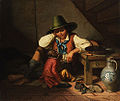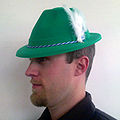Tyrolean hat


The Tyrolean hat (Template:Lang-de, Template:Lang-it), also Bavarian hat or Alpine hat, is a type of headwear that originally came from the Tyrol in the Alps, in what is now part of Austria, Germany, Italy and Switzerland.
A typical Tyrolean hat originally had a crown tapering to a point and was made of green felt with a brim roughly the width of a hand, something that was especially common in the Zillertal.[1]
There are various forms of Tyrolean hat. Frequently the hats are decorated with a coloured, corded hatband and a spray of flowers, feathers or "brush" at the side of the crown. The traditional "brush" is made of the beard of the chamois goat. It takes a variety of forms, and may often be combined with feathers.[2]
The Tyrolean hat became even more well known thanks to Edward VIII who, after his abdication, frequently stayed in Austrian Styria and often wore a hat of Tyrolean style, although it did not come from there.[3]
In the 19th and 20th centuries, Tyrolean costumes developed a certain degree of uniformity in their appearance. In the local village costumes of the Tyrol, the various styles of Tyrolean hat have survived since the 1830s/40s, albeit similar to those of contemporary fashion. These original forms vary from the tall, relatively narrow-brimmed hats of North Tyrol which were dented on top, to the small, wide-brimmed hats of the South Tyrolean wine country.
Later the Tyrolean hat became the image bearer of "Tyrolean culture" as a tourist symbol, influenced also by folk music bands who wore fanciful "local" costumes. The musician, Billy Mo, wrote a song in 1962 called "I Prefer to Buy a Tyrolean Hat", which reinforced the link between the hat and traditional Alpine (brass band) folk music. In 1965, a comedy musical appeared under the same title.[4]
It is said that the Tyrolean hat was the inspiration for the homburg.[5]
-
Boy with Tyrolean hat and monkey (Knabe mit Tirolerhut und Äffchen). Oil on canvas, c. 1834
-
Andreas Hofer, wearing the typical, broad-brimmed flat hat of the South Tyrolean type (posthumous portrait, mid-19th century)
-
Self portrait with Tyrolean hat (Selbstporträt mit Tiroler Hut), Lovis Corinth
-
Simple, party version of the Tyrolean hat
-
Tyrolean hat with Volksmarching pins
References
- ^ "[T]he pointed, green, felt hat with a hand-wide brim, which came from South Tyrol, especially from the Ziller valley, earned such a reputation that it was referred to as a Tyrolean hat." Heinrich Heine: Reisebilder II: 1828-1831 : Kommentar, Volume 6. Akademie Verlag, 2003, p. 232 (N.B.: the Ziller valley lies in North Tyrol)
- ^ Kilgour, Ruth Edwards (1958). A Pageant of Hats Ancient and Modern. R. M. McBride Company.
- ^ Lexikon der Herrenmode, Musterschmidt, 1960
- ^ Ich kauf mir lieber einen Tirolerhut. Moviepilot.de
- ^ Grunwald, Torsten (2014). Den Velkædte Mand. Forlaget Vandkunsten. p. 147. ISBN 978-87-76-95362-1.





